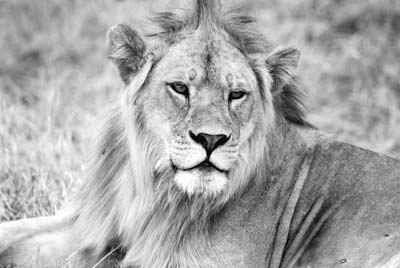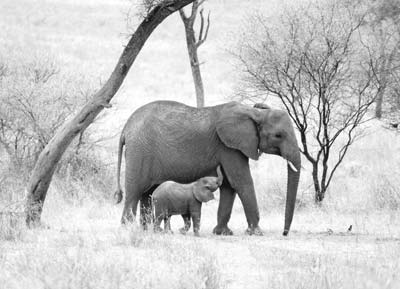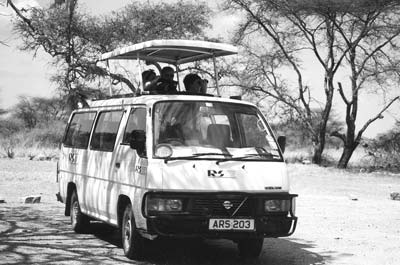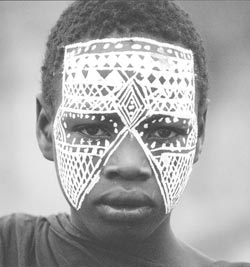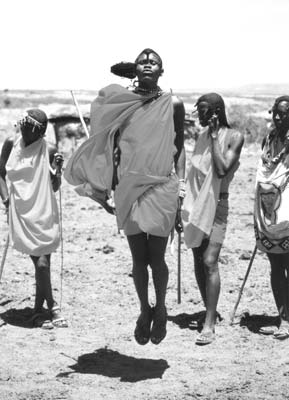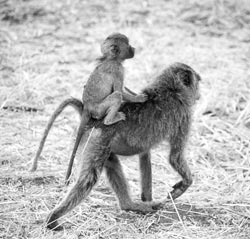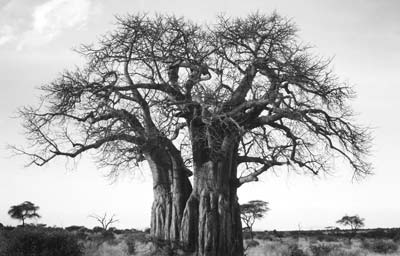A wealth of wildlife in East Africa
by Donna Jurado, San Francisco, CA. Photos by Joan and Elena Jurado.
My daughters, Joan and Elena, and I were enthralled, watching the strutting display of a male ostrich hoping to impress his intended mate. His face, neck and legs were an intense bright pink during this breeding season. Suddenly, our guide diverted our attention across the grassy savannah, where several lions were engaged in the hunt. The inevitable happened and a hapless zebra soon became lunch for a hungry pride.
We drove closer and observed the lions in their grisly rite. Finally they emerged from the carcass with very red, wet heads, faces and paws. They soon had their fill and several of them strolled over toward us and lay down to digest their meal in the welcome shade of a neighboring jeep barely two meters away. This was the only shade available in the savannah area of the Ngorongoro Crater in Tanzania.
The excitement continued as dozens of small heads began to pop up out of the grass for miles in all directions. The hyenas were going to try their luck at snatching a scrap of the prize. Alas, they would have to wait for evening and darkness, as the rightful owners of the zebra carcass awakened and in a rush drove the scavengers away.
This lion encounter was just one of hundreds of nonstop animal and bird sightings that astonished and thrilled us on our 25-day safari in Kenya and Tanzania in October ’02.
A custom safari
Our private, customized tour was the third such tour organized by Nino Mohan, owner of Worldview Tours (Box 11417, Newport Beach, CA 92658; phone 800/373-0388 or e-mail nino@worldviewtours.com).
Nino did just as great a job for us in Africa as he did on previous tours to India, Nepal, Bhutan, Tibet and Thailand. Our safari cost $5,300 each, which included air from San Francisco to Nairobi on British Airways, all meals except in Nairobi and a single supplement for me so I could have my own room and bath.
We were glad that we opted for a private safari bus; the three of us had ample space to move around freely for the best viewing and photographs, and we had plenty of room to store our safari gear and cases of water, which we had purchased in Nairobi at a fraction of the price we would have been charged at the lodges. Most importantly, we were able to plan our itinerary exactly as we wanted it.
We felt at home in the colonial atmosphere of the Stanley Hotel in Nairobi and found its Thorn Tree Café to be very good, particularly its Indian dishes. We greatly enjoyed our visit to the National Museum, where an exceptional exhibit of watercolors by Joy Adamson is on display. Her work portrays the tribal dress and customs of the people who lived around her home near Samburu.
We gift shopped at the Collector’s Den, a fairly priced, quality curio shop in the heart of Nairobi. My daughter purchased an exquisite ebony carving of a giraffe and baby for $120 after bargaining hard from the original price of $350.
Animal sightings
Our first destination on safari, and one of our favorite parks, was Shaba National Reserve. We stayed at Sarova Shaba Lodge, which is beautifully located right on the Ewaso Ngiro River. The large, well-appointed upstairs rooms in the cottages overlooked the river and the trees, where monkeys staged a continuous show.
On our game drives we explored Shaba, Buffalo Springs and Samburu national reserves, enjoying the majestic scenery with views of Mt. Shaba and Mt. Samburu. Our sighting along the river of a herd of at least 50 elephants of all sizes was magnificent. Klipspringer, beisa oryx, reticulated giraffe, Grevy’s zebra and gerenuk (or giraffe gazelle) are seen fairly often here as well.
Serena Mountain Lodge in Mt. Kenya National Park was unique, with cozy wood-paneled rooms each with its own private balcony overlooking a constant parade of animals visiting the water hole below. We signed up for a 2-hour naturalist-guided walk, escorted on each end by several machine gun-toting guards. We were served a “bush tea” in the middle of the forest, where the most dangerous animal we encountered was a chameleon which fell into my lap from the trees above.
At Sarova Lion Hill Lodge in Nakuru, we were upgraded to a suite, complete with a fireplace and tastefully decorated with modern African art.
Lake Nakuru was incredible. Besides enjoying the overwhelming beauty and experience of seeing and listening to hundreds of thousands of flamingos and pelicans feeding at the lake, we were able to sit right in the center of a herd of 10 white rhino.
To top it all off, at dusk we found two very relaxed leopards lounging high up in the trees. With the leopard sighting, we were lucky to have seen the “big five” during our first four days on safari.
We especially liked Sarova Mara Tented Camp in the Masai Mara Reserve. The three of us were given two cozy tents on top of the hill, both with all the creature comforts. Since we were on the edge of the camp, we could hear all the exciting animal sounds at night and were blessed with four adorable dik-diks residing in our front yard.
The fame and expansiveness of the Mara did not disappoint us. Besides an abundance of zebra, wildebeest and antelope, we saw a black rhino and many handsome topis, beautiful in black and tan. Our guide, Raffi, spotted some special baby animals for us: a cheetah with four soft, fluffy kittens in tow and a lioness, aunt and four cubs breakfasting on a zebra.
After seven days on safari we returned to Nairobi for a night at the Stanley Hotel, where we indulged in a much needed freshening up and the luxury of a massage before continuing on to Amboseli and Tanzania.
Amboseli National Park
Last on our itinerary in Kenya was Amboseli National Park, where we took a shortcut across the salt flats of a dry lake bed. We were rewarded with a mirage of a striking lake scene and many interesting “dust devils.”
At this point, one of our safari van’s tires succumbed to the hours of bumping and jolting on Kenya’s potholed roads. But getting a flat was a mild nuisance in comparison to the excitement of being surrounded by a herd of gentle zebra when we had to get out of the vehicle. Fortunately, we were not visited by the many prides of lions that we had encountered on previous days!
We stayed at Amboseli Serena Safari Lodge, which was the only accommodation on our tour that was in dire need of renovation and remodeling. Fortunately, as at all the other lodges, the food and service were excellent.
A one-hour animal parade just below the pool area at dusk was a thrilling attraction, with even lions passing through barely 100 feet from the lodge.
While at Amboseli we visited Tortilis Tented Camp, with lovely views of Kilimanjaro, and the tents and social areas of the camp looked to be very inviting.
On to Tanzania
From Amboseli we drove to Namanga, your typical border town, where we got our Tanzanian visas stamped. We then bid farewell to Raffi Shabbai, our faithful guide and driver from Pollman Tours & Safari, changed vehicles and met our Tanzanian Ranger Tours’ guide and driver, Hassan Marandu. We drove on to Lake Manyara to spend the night at Lake Manyara Serena Safari Lodge up on the hill overlooking the lake.
The Manyara area was a dust bowl due to road construction between Arusha and Ngorongoro. We did see some bird life the next morning but no tree-climbing lions, which I have come to believe are somewhat of a fantasy.
Ngorongoro Crater
We continued on up the escarpment of the Rift Valley to the rim of the Ngorongoro Crater, where we had a delicious lunch in the spectacular dining room of the Ngorongoro Serena Safari Lodge.
The road to the Serengeti was slow, potholed and torturous, but this should improve in 2004 when road construction between Arusha and the Serengeti is scheduled to be completed. The long drive was well worth it, as upon entering the park we saw two prides of lions atop rocky outcroppings enjoying the late afternoon sun.
We spent three nights at Serengeti Sopa Lodge, with comfortable, large rooms, a sitting room and balcony.
The profusion of wildlife here defies description, and the park is justly famous for its prides of lions.
On our way to Ngorongoro we stopped at Olduvai Gorge, where we contemplated the beginnings of mankind. The museum here was interesting, with many photos of the history of David and Mary Leakey and a reproduction of the footprints of our earliest ancestors.
We enjoyed our two nights at Ngorongoro Sopa Lodge, located on the rim of the crater. Rooms were large and, since it gets very chilly at an altitude of 7,000 feet, we welcomed our little, glass-enclosed, solar-heated porches.
The crater is such a special place and a genuine surprise. From the rim, it looks like an uninhabited moonscape, but when we went down into it we found it teeming with all kinds of animals and birds. Besides the lion-hyena show, we especially remember a wonderful sighting of two endangered black rhino, not to mention a baby leopard crossing the road right in front of our jeep and over 50 species of birds, including many eagles and some very aggressive black kites at Lake Magadi that wanted our picnic lunch and perhaps a finger.
Tarangire
Upon leaving Ngorongoro, six hours of driving took us to Tarangire, where we spent three nights at Tarangire Sopa Lodge relaxing a bit at the end of our safari.
We loved Tarangire. It is wild and uncrowded, and its topography makes it perhaps the most beautiful of all the parks in Tanzania. Besides the spectacular baobab trees, there are grasslands, swamps, rivers and hills and many large sausage trees, a favorite sleeping place for leopards.
Tarangire is famous for its numerous elephant families with wee calves, which the mothers try to hide and protect. But, to our delight, sooner or later a pair of little ones would dash out from underneath their mothers to stage a mock battle and roughhouse a little.
On our last day on safari we were lucky to spot two enormous pythons digesting their food high up in some trees along the river. In this gem of a park we even found orchids — large plants with long sprays of yellow oncidium-type flowers.
On reflection
While we have nothing but praise for our experience, there was an aspect of our safari that concerned us.
We would be on the road observing an animal from a respectful distance when, frequently, another safari-vehicle driver would decide to get a better view for his clients and drive off-road to intrude upon the space of the animal, without considering the impact on the animal and its young or the ecological consequences of off-road driving.
I believe that more emphasis needs to be made in educating both the travelers and drivers in order to halt this unnecessary exploitation of the animals and park environment.
I would like to say that, besides remembering the magnificent animals, we have cherished memories of our driver guides, Raffi and Hassan, and of all the wonderful people of Kenya and Tanzania. We found them to be gentle, hospitable and friendly and to respect and love life, and their camaraderie, service, lively music and dance added flavor to our safari.


